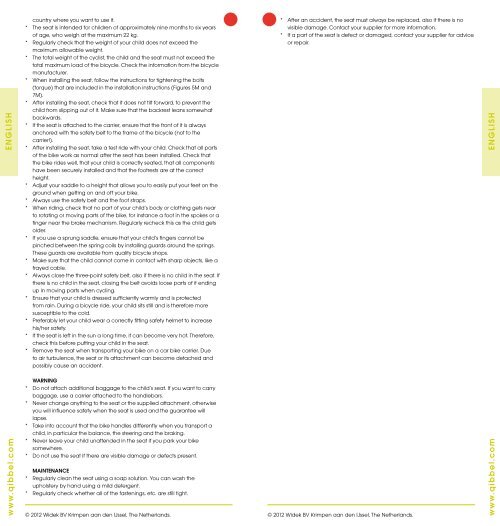INSTALL A TION INSTRUCTIONS NL Gebruiksaanwijzing ... - Qibbel
INSTALL A TION INSTRUCTIONS NL Gebruiksaanwijzing ... - Qibbel
INSTALL A TION INSTRUCTIONS NL Gebruiksaanwijzing ... - Qibbel
You also want an ePaper? Increase the reach of your titles
YUMPU automatically turns print PDFs into web optimized ePapers that Google loves.
ENGLISH<br />
www.qibbel.com<br />
country where you want to use it.<br />
* The seat is intended for children of approximately nine months to six years<br />
of age, who weigh at the maximum 22 kg.<br />
* Regularly check that the weight of your child does not exceed the<br />
maximum allowable weight.<br />
* The total weight of the cyclist, the child and the seat must not exceed the<br />
total maximum load of the bicycle. Check the information from the bicycle<br />
manufacturer.<br />
* When installing the seat, follow the instructions for tightening the bolts<br />
(torque) that are included in the installation instructions (Figures 5M and<br />
7M).<br />
* After installing the seat, check that it does not tilt forward, to prevent the<br />
child from slipping out of it. Make sure that the backrest leans somewhat<br />
backwards.<br />
* If the seat is attached to the carrier, ensure that the front of it is always<br />
anchored with the safety belt to the frame of the bicycle (not to the<br />
carrier!).<br />
* After installing the seat, take a test ride with your child. Check that all parts<br />
of the bike work as normal after the seat has been installed. Check that<br />
the bike rides well, that your child is correctly seated, that all components<br />
have been securely installed and that the footrests are at the correct<br />
height.<br />
* Adjust your saddle to a height that allows you to easily put your feet on the<br />
ground when getting on and off your bike.<br />
* Always use the safety belt and the foot straps.<br />
* When riding, check that no part of your child’s body or clothing gets near<br />
to rotating or moving parts of the bike, for instance a foot in the spokes or a<br />
finger near the brake mechanism. Regularly recheck this as the child gets<br />
older.<br />
* If you use a sprung saddle, ensure that your child’s fingers cannot be<br />
pinched between the spring coils by installing guards around the springs.<br />
These guards are available from quality bicycle shops.<br />
* Make sure that the child cannot come in contact with sharp objects, like a<br />
frayed cable.<br />
* Always close the three-point safety belt, also if there is no child in the seat. If<br />
there is no child in the seat, closing the belt avoids loose parts of it ending<br />
up in moving parts when cycling.<br />
* Ensure that your child is dressed sufficiently warmly and is protected<br />
from rain. During a bicycle ride, your child sits still and is therefore more<br />
susceptible to the cold.<br />
* Preferably let your child wear a correctly fitting safety helmet to increase<br />
his/her safety.<br />
* If the seat is left in the sun a long time, it can become very hot. Therefore,<br />
check this before putting your child in the seat.<br />
* Remove the seat when transporting your bike on a car bike carrier. Due<br />
to air turbulence, the seat or its attachment can become detached and<br />
possibly cause an accident.<br />
WARNING<br />
* Do not attach additional baggage to the child’s seat. If you want to carry<br />
baggage, use a carrier attached to the handlebars.<br />
* Never change anything to the seat or the supplied attachment, otherwise<br />
you will influence safety when the seat is used and the guarantee will<br />
lapse.<br />
* Take into account that the bike handles differently when you transport a<br />
child, in particular the balance, the steering and the braking.<br />
* Never leave your child unattended in the seat if you park your bike<br />
somewhere.<br />
* Do not use the seat if there are visible damage or defects present.<br />
MAINTENANCE<br />
* Regularly clean the seat using a soap solution. You can wash the<br />
upholstery by hand using a mild detergent.<br />
* Regularly check whether all of the fastenings, etc. are still tight.<br />
© 2012 Widek BV Krimpen aan den IJssel, The Netherlands.<br />
* After an accident, the seat must always be replaced, also if there is no<br />
visible damage. Contact your supplier for more information.<br />
* If a part of the seat is defect or damaged, contact your supplier for advice<br />
or repair.<br />
ENGLISH<br />
© 2012 Widek BV Krimpen aan den IJssel, The Netherlands. www.qibbel.com


